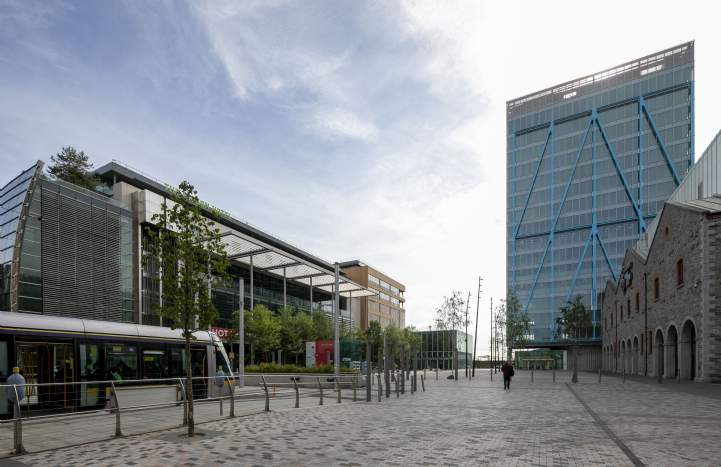As the built environment comes under continued pressure to meet the sustainability standards set out in the EU Performance of Buildings Directive, and as occupiers and developers adapt their practices in line with their ESG values and targets, acronyms abound on new build office developments each declaring a different type – or sometimes multiple types – of sustainability accreditation.
Among the myriad of certifications available, ones seen frequently in the Dublin office market include LEED, BREEAM, GRESB, WELL, WiredScore, BER , Activescore and EPC.
To better understand their nuances, we have broken them down below.
LEED (Leadership in Energy and Environmental Design)
LEED, developed by the U.S. Green Building Council (USGBC), is perhaps the most well-known sustainability accreditation globally. LEED operates on a point-based system, assessing various aspects of a building's environmental performance, such as energy efficiency, water conservation, materials selection, and indoor environmental quality. There are different levels of LEED accreditation: Certified, Silver, Gold, and Platinum, based on the number of points achieved. It has become a global standard for green building design and construction since its inception in the US. Office developments in the Dublin market boasting a LEED Platinum rating include 15 George’s Quay and The EXO Building, and buildings such as Two Dublin Airport Central have achieved LEED Gold certification.

BREEAM (Building Research Establishment Environmental Assessment Method)
Originating from the UK and developed by the Building Research Establishment (BRE), BREEAM assesses several categories including building location, energy use, materials used, water, pollution, and management. BREEAM also offers different ratings, ranging from Pass, Good, Very Good, Excellent, and Outstanding, decided by a weighted scoring system (not points).
While LEED had been designed specifically for buildings in the US, BREEAM has adapted to British and European construction laws and best practices. It uses licensed accessors who examine the building against the credit criteria – LEED applications are made via a submission rather than licensed assessment. BREEAM as a scheme has been widely used in Ireland – examples in the Dublin office market include Fitzwilliam 28 which was designed to be BREEAM excellent.
GRESB (Global Real Estate Sustainability Benchmark)
Rather than certifying individual buildings, GRESB assesses the ESG performance of entire real estate portfolios. It’s a valuable tool for investors to evaluate the sustainability performance of their real estate investments. Funds, REITs, developers, asset managers all use GRESB to assess their ESG performance, done in a globally recognised framework.
GRESB evaluates factors like energy consumption, greenhouse gas emissions, water usage, waste management, and stakeholder engagement.
NZEB (Nearly Zero Energy Building)
NZEB specifically targets energy efficiency and is most widely used within the European Union, with the EU being a leader in promoting and implementing its standards. To be accredited as a ‘Nearly-Zero Energy Building’ means that building has a very high energy performance, and the very low amount of energy required by the building should be covered to a significant extent by energy from renewable resources.
The energy performance is typically measured through efficient design, insulation, renewable energy sources, and advanced technologies.
In Ireland, with the introduction of the Energy Performance of Buildings Directive, the NZEB standard applies to all new buildings built after 31st December 2020, and all public sector buildings built from 31st December 2018.
When the European Commission revised the Energy Performance of Buildings Directive, it made a step forward from NZEB to ZEB, using technology such as heat pumps, high efficiency windows and insulation and solar panels. This net zero consumption means that the total amount of energy used by the building on an annual basis is equal to the amount of renewable energy created on the site or is sustainably procured. ZEB is closely in line with the EU target of climate neutrality. While buildings such as North Dock, The EXO, Charlemont Square and 15 George's Quay are NZEB office buildings, we expect to see ZEB rated buildings come to market in the coming years.
The choice of sustainability accreditation in commercial real estate depends on various factors such as geographic location, project scope, sustainability goals, and investor preferences. Ultimately, embracing sustainability accreditations is not just a trend but a strategic imperative for the future of commercial real estate.
Conor Egan, Savills Offices

WELL
While the previous acronyms focused on environmental sustainability, the WELL building standard is focused on the social impact of buildings.
WELL is an internationally used system that measures, monitors and certifies a series of features to promote occupant wellbeing and make sure buildings are healthy environments to work, live and socialise in. It investigates the concepts of air, water, nourishment, light, fitness, comfort, and mind. Securing WELL certification for a building enhances its appeal for tenants who can view it as a lever to attract top talent, improve productivity, reduce sick days, and increase employee happiness and engagement.
WELL certified offices in Dublin include 15 George's Quay and Charlemont Square which are WELL enabled, and Fitzwilliam 28 which has WELL Gold certification.
WiredScore
WiredScore certification recognises the digital connectivity and infrastructure in commercial real estate. It measures factors such as internet connectivity, network resilience and technological amenities to ensure the building meets the needs of modern tenants. WiredScore certifications are provided following an audit process and standards range from Qualified, Silver, Gold to Platinum. WiredScore is a popular certification in the office market with Charlemont Square, The EXO, Two Dublin Airport Central and more all boasting a cert.
ActiveScore
ActiveScore is the accreditation for Active Travel provision in real estate, recognised for meeting the highest standards of active travel friendliness. It means that the infrastructure of the building meets the requirements of the modern commuter; it takes into account everything from bike racks, way-finding and showers to bike servicing and designated ‘Active Travel’ user groups. ActiveScore certification levels range from Certified, Silver, Gold and Platinum,
Charlemont Square has been ActiveScore certified Platinum, highlighting the commitment to providing best-in-class cycling facilities for tenants and fostering a healthy workplace for occupiers.
BER / EPC
Finally, most are probably aware of the Building Energy Rating that is applied to buildings in Ireland, both residential and commercial. The EPC, Energy Performance Certificate, is a similar accreditation that is used outside of Ireland. The EPC shows the energy performance on an easily readable scale from A to G, whereas the BER is more detailed in its subdivision from A1, A2, A3 to B1, B2, B3 and so on, also as far as G. In the Republic of Ireland, a BER Cert is compulsory for all homes and commercial buildings offered for sale or rent. In Europe, the same applies for an EPC.
.jpg)
In conclusion, the choice of sustainability accreditation in commercial real estate depends on various factors such as geographic location, project scope, sustainability goals, and investor preferences. Ultimately, embracing sustainability accreditations is not just a trend but a strategic imperative for the future of commercial real estate.









